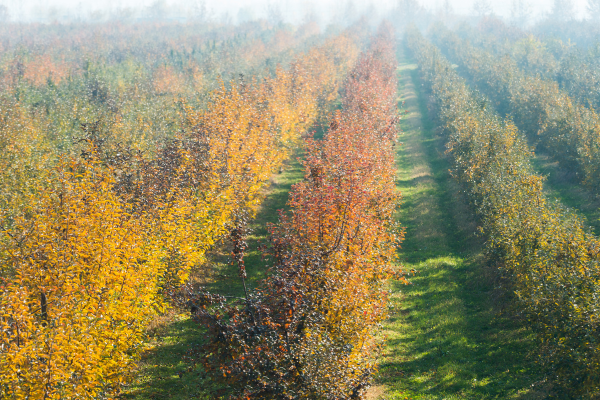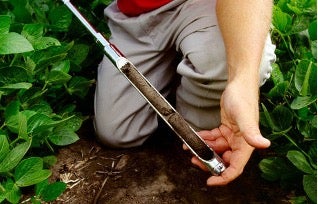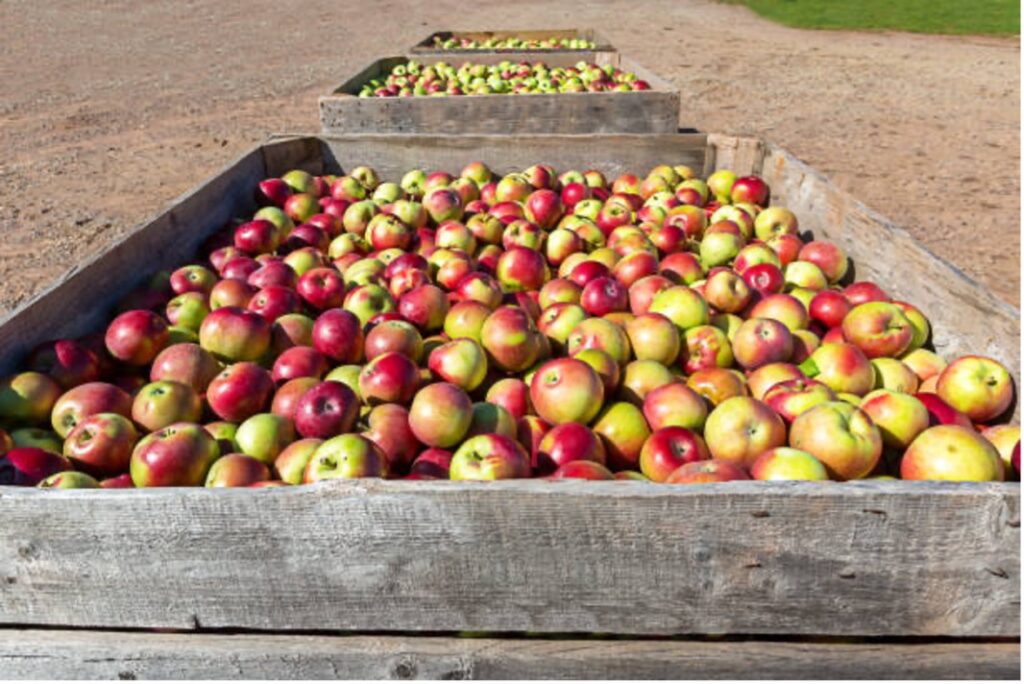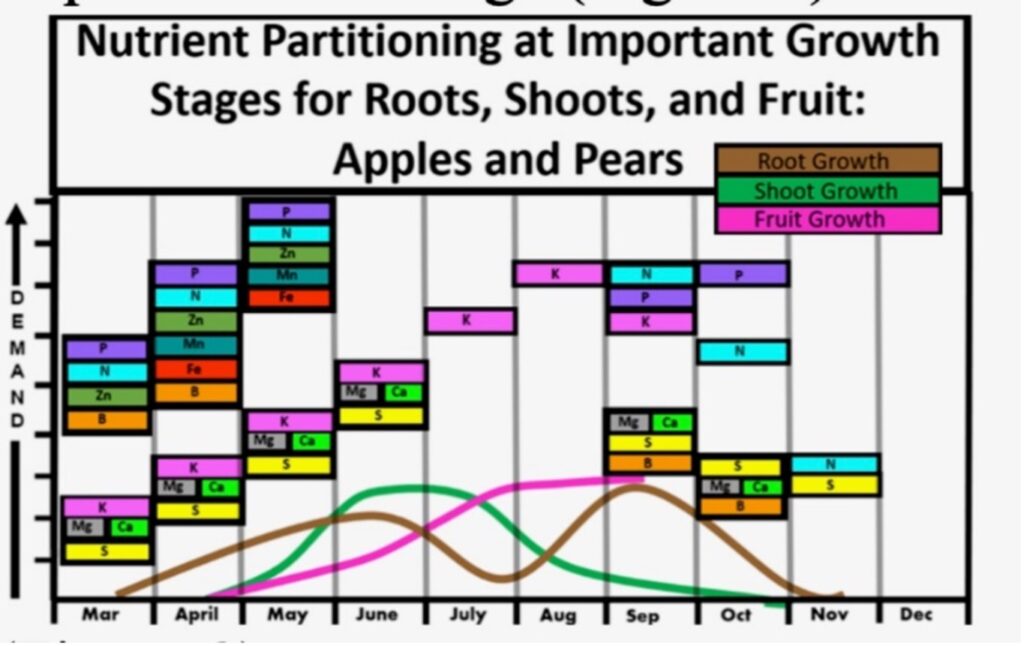
Importance of Fall Fertility in Apples and Pears
The best time to apply post-harvest fall fertilizer is right after harvest. The tree has just been through harvest and a tough growing season and needs to be replenished for the winter. Also, typically after harvesting, for most varieties, there is still an opportunity to get some irrigation cycles on to incorporate the fertilizer into the soil. Post-harvest is also when root activity is at its largest, so the proper amount of water and nutrition can really set up the crop nicely for next year.
Looking at Image 1 (above), you can see that at post-harvest during root growth, many nutrients are required.
 A proper soil test is necessary to help accurately apply the correct amount of fertilizer. Not all soil tests are built the same. As a tree fruit agronomist in the PNW, I like to see the REN test (Organic Acid Test) run. Organic Acid is a modification of an original soil extractant that mimics the plant roots’ natural process for acquiring nutrients. The soil is mixed with organic acids of 4.4 pH, which will mimic the acid, a root tip exudate that will be used to mine nutrients. I personally like to see a complete test run at least once every three years to better anticipate what nutrients will be available in the coming years. Once these tests are analyzed for nutrition levels, we will be able to put together an appropriate blend for the grower’s specific soil.
A proper soil test is necessary to help accurately apply the correct amount of fertilizer. Not all soil tests are built the same. As a tree fruit agronomist in the PNW, I like to see the REN test (Organic Acid Test) run. Organic Acid is a modification of an original soil extractant that mimics the plant roots’ natural process for acquiring nutrients. The soil is mixed with organic acids of 4.4 pH, which will mimic the acid, a root tip exudate that will be used to mine nutrients. I personally like to see a complete test run at least once every three years to better anticipate what nutrients will be available in the coming years. Once these tests are analyzed for nutrition levels, we will be able to put together an appropriate blend for the grower’s specific soil.
Importance of Nutrition
 The right fertilizer blend will set up the tree nicely for next year’s success. Calcium is generally applied as it has many fundamental roles in trees. Remember, calcium will not be translocated at budburst into flowers and leaves until there is sufficient root growth when the soil warms up. So having a reserve of Calcium available in fruit buds will ensure levels are adequate over flowering and fruit set, and this helps to build strong fruit. Boron is most effectively applied immediately post-harvest. Boron is needed for pollen tube formation and therefore fruit set. Good boron levels mean more seeds are set; the higher the seed numbers, the higher the calcium levels in the fruit. Phosphorus is primarily taken up into the tree through the roots so having adequate amounts during root flush is important. Phosphorus is an essential element during early stages and for cell division. Potassium will help the tree during adverse weather conditions such as cold winter conditions. Also, potassium is involved in increasing root growth while maintaining a balance of salts and water in the soil. Especially with many of our dwarfing rootstocks and sandy soils adequate soil K is important to get K in the root zone and watered in.
The right fertilizer blend will set up the tree nicely for next year’s success. Calcium is generally applied as it has many fundamental roles in trees. Remember, calcium will not be translocated at budburst into flowers and leaves until there is sufficient root growth when the soil warms up. So having a reserve of Calcium available in fruit buds will ensure levels are adequate over flowering and fruit set, and this helps to build strong fruit. Boron is most effectively applied immediately post-harvest. Boron is needed for pollen tube formation and therefore fruit set. Good boron levels mean more seeds are set; the higher the seed numbers, the higher the calcium levels in the fruit. Phosphorus is primarily taken up into the tree through the roots so having adequate amounts during root flush is important. Phosphorus is an essential element during early stages and for cell division. Potassium will help the tree during adverse weather conditions such as cold winter conditions. Also, potassium is involved in increasing root growth while maintaining a balance of salts and water in the soil. Especially with many of our dwarfing rootstocks and sandy soils adequate soil K is important to get K in the root zone and watered in.
Table 2. Tree fruit demand for primary macronutrients per ton of fruit harvested.
| Crop | lb N/ton | lb P/ton | lb K/ton | lb Ca/ton | References |
|---|---|---|---|---|---|
| Apples (Red) | 0.9 – 2.1 | 0.2 – 0.4 | 2.0 – 3.9 | 0.10 – 0.22 | Cheng and Raba 2009; Palmer and Dryden 2006; Sallato, 2021. |
| Pear | 1.3 – 2.7 | 0.6 | 3.7 | – | Silva and Rodriguez 1995 |
Throughout our growing area, many of our soils have high pH as well as high salts, it’s recommended a light rate of humic or fulvic acid to help delineate any issues around high soluble salts. Balancing the ratios of key elements is also crucial in addition to addressing nutrient deficiencies. Post-harvest fertilization plays a vital role in preparing for the upcoming crop season. This period is favorable for nutrient uptake since the trees remain active, allowing roots to absorb the applied nutrients. These absorbed nutrients serve as reserves for the following growing season.
SUMMARY
The nutrition applied in the fall has a crucial impact on the tree and fruit in the upcoming year. Horticultural practices also play a key role in setting up next year’s crop. These storage nutrients are essential for sustaining growth during stressful periods, dormancy, and the initiation of growth in the spring. It is important to find the right balance of nutrients to promote both vegetative and reproductive growth for consistent and quality fruit production. Through effective fertilizer management, the goal is to produce healthy trees with moderate vigor and high-quality fruit. Getting fertilizer applied and watered in quickly, will help achieve better nutrient uptake.
Benjamin Sullivan // Tech Nutrition Agronomist
Acknowledgment:
The above has some info extracted from an article by Dean Rainham, Horticultural Consultant at AgFirst dean.rainham@agfirst.co.nz. Also, information was supplied by Dr. Deepak Mathur, Ph.D. Senior Technical Manager (International) Agrichem Australia.
Weinbaum, S.A., I. Klein, F.E. Broadbent, W.C. Micke and T.T. Muraoka. 1984. Effects of time of nitrogen application and soil texture on the availability of isotopically labeled fertilizer nitrogen to reproductive and vegetative growth of mature almond trees. J. Am. Soc. Hortic. Sci. 109:339–343.
Neilsen D. and G. Neilsen 2008. Managing Nutrition for High Density Apple and Sweet Cherries. USHA Convention.


